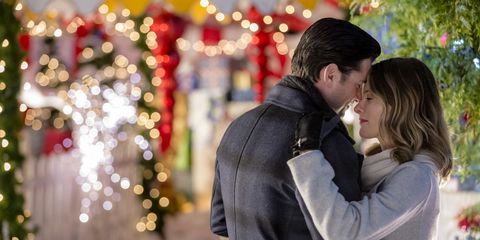I have a confession to make: I love Hallmark Christmas Movies.
The ubiquitous mugs of steaming hot cocoa, trays of frosted cookies, endless sparkle and bokeh effects, and overt sentimentality bring me comfort on these too-short days at the end of the Fall semester.
At the same time, the films frustrate me with their limited representation of contemporary American society–a multicultural, multi-religious, nation of people of diverse sexualities. While Hallmark has made some progress in feature people of color in the leading romantic roles, most people of color are featured in supporting roles. And while Hallmark hyped the debut of several Hanukkah movies in 2019–a first for the network–the synopses of these two films shows that Hanukkah is a side plot alongside, you guessed it, Christmas celebrations. Additionally, the films continue to represent only heterosexual romantic and sexual attraction. As Ruth Schneider notes, despite commitment to LGBTQ representation in other aspects of Hallmark company and products, there is no representation in these popular movies. The television network has a long and complex history that includes previous ties to religious broadcasting companies; Crown media purchased Odyssey and Faith and Values channels, rebranded as Hallmark Channel. This may explain why there has been no movement on LGBTQ inclusion.
At the same time, the films are doing interesting feminist work. One of the most intriguing ways is through the male heroes. Most of the films feature romantic heroes that challenge traditional norms of masculinity. Many of the heroes are what those in Romancelandia call “cinnamon rolls.” These heroes are soft, sentimental, and sweet. These men are in touch with their feelings and emotionally available to the women in their lives, in stark contrast to traditionally masculine, alpha heroes who need to learn how to love others. Hallmark holiday movies create a fantasy where men are already fully emotionally evolved, a positive development for people of all genders.
Many of these films meet the narrative criteria of the popular romance genre, more commonly applied to novels, but also applicable here. The Romance Writers of American define the romance genre with two criteria: “a central love story, and a emotionally satisfying and optimistic ending.” This combination centers characters’ emotional lives, and also guarantees that those with good intentions have their emotional needs met by the end of the film. Centering and celebrating emotional connection resonates with many viewers, and provides a sense of comfort and joy, especially during times laden with uncertainty. The bonus, for those who celebrate Christmas, is this formula is wrapped in the familiar trappings of the season, and tied with the bow of a happily-ever-after.
Do you want to enjoy a little holiday fun and critical thinking at the same time? Join Dr. Ryan Martin and me for “Unwrapping Hallmark Holiday Movies: A Live Viewing and Discussion” on Wednesday, December 4, from 2:50-5:30 pm at the Student Life Couches. We’ll watch Christmas in Homestead live, facilitate discussion, and play Hallmark movie bingo. This event is sponsored by CAHSS, Feminists 4 Action, the English Department, and Women’s and Gender Studies Program.
Additionally, you can catch a fuller presentation of my research “I’m Dreaming of a Straight, White Christmas: Normative Romance and Nostalgia in Hallmark Holiday Movies” at the Lester Public Library in Two Rivers, Wisconsin on Wednesday, December 11 at 6:00 pm.

By Dr. Jessica Lyn Van Slooten
Jessica Lyn Van Slooten is an Associate Professor of English, Writing, and Women’s and Gender Studies at the University of Wisconsin Green Bay. She teaches courses on women writers, gender and popular culture, romance writing, and more. Jessica has published numerous articles on teaching and assessing gender studies courses, and popular romance fiction and film. She is currently drafting a romance novel set in a small midwestern town.

I agree, like cinnamon rolls, they’re both addictive and (mentally) nutrition free. My wife enjoys them, I find them kind of creepy. If you just pay attention to the soundtrack, these movies tend to sound like a romantic version of Jaws. (or better yet, Hitchcock) “Dink-Dink-Dink” usually violin or just piano…someone has noticed someone “dink-dink-dink” someone has just noticed someone back…”dink-dink-dink” the first someone pretends not to notice the second someone has just noticed them back. No full orchestration between the characters until a first kiss!
I’m going to be honest: no amount of sub rosa subversion is going to make me enjoy a Hallmark Christmas movie. However, I am deeply grateful to the Hallmark network for hiring some women screenwriters whom Hollywood has squandered, like SF/fantasy Dynamo and 1980s feminist Caroline Thompson. Go Hallmark!